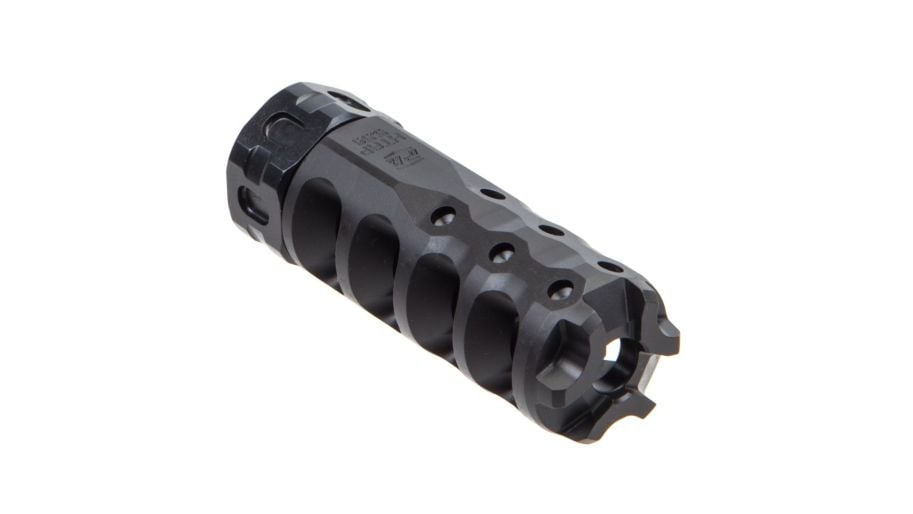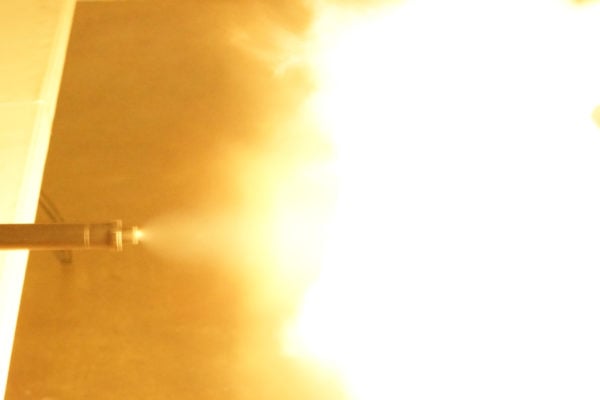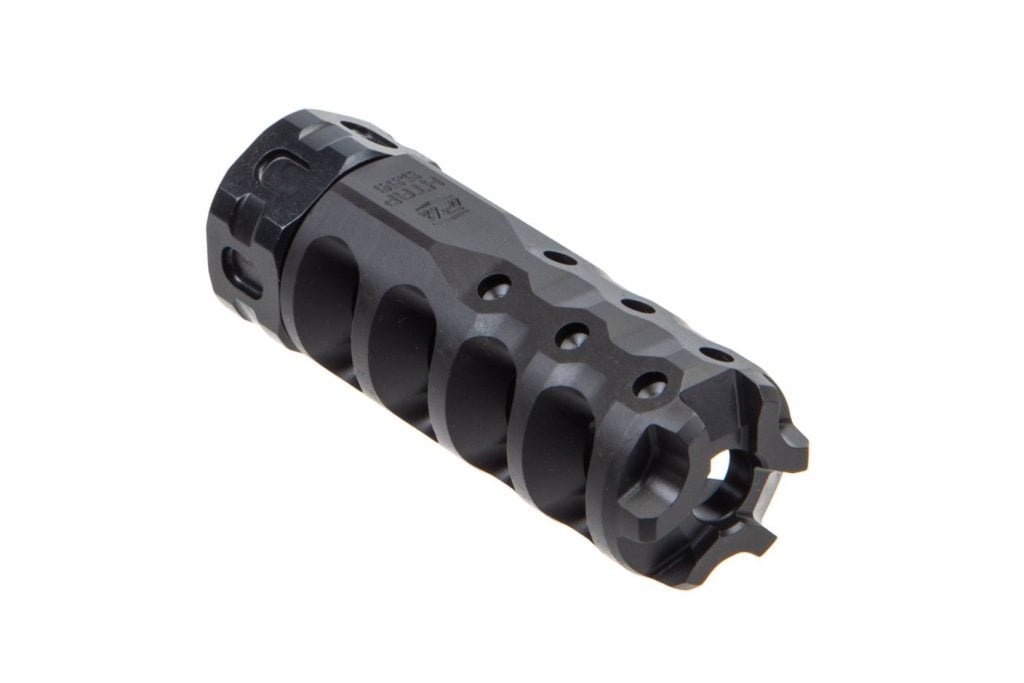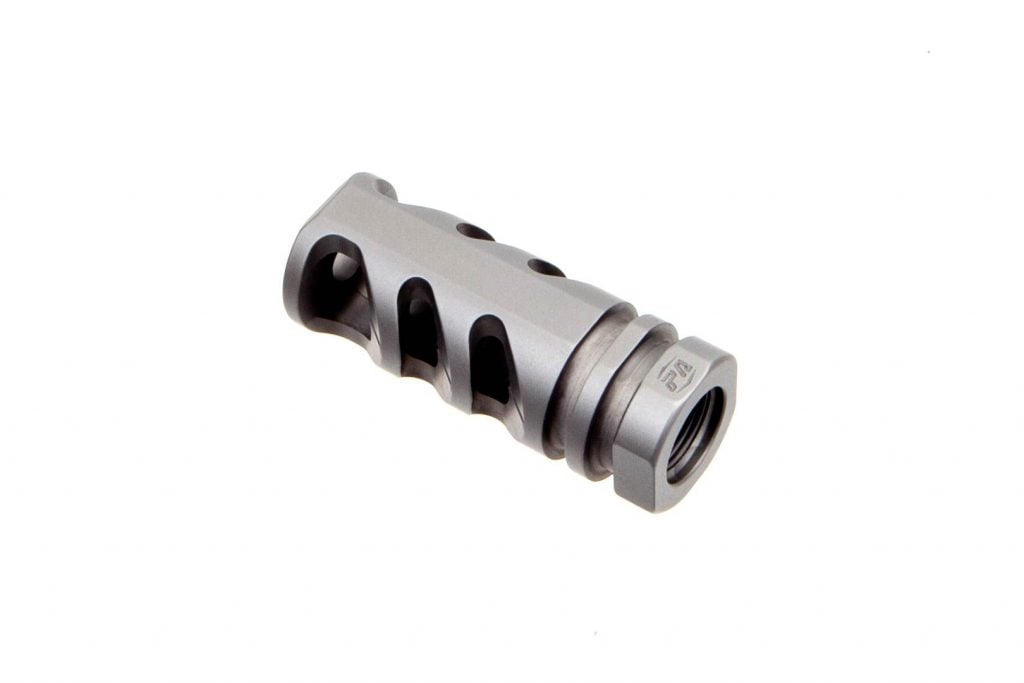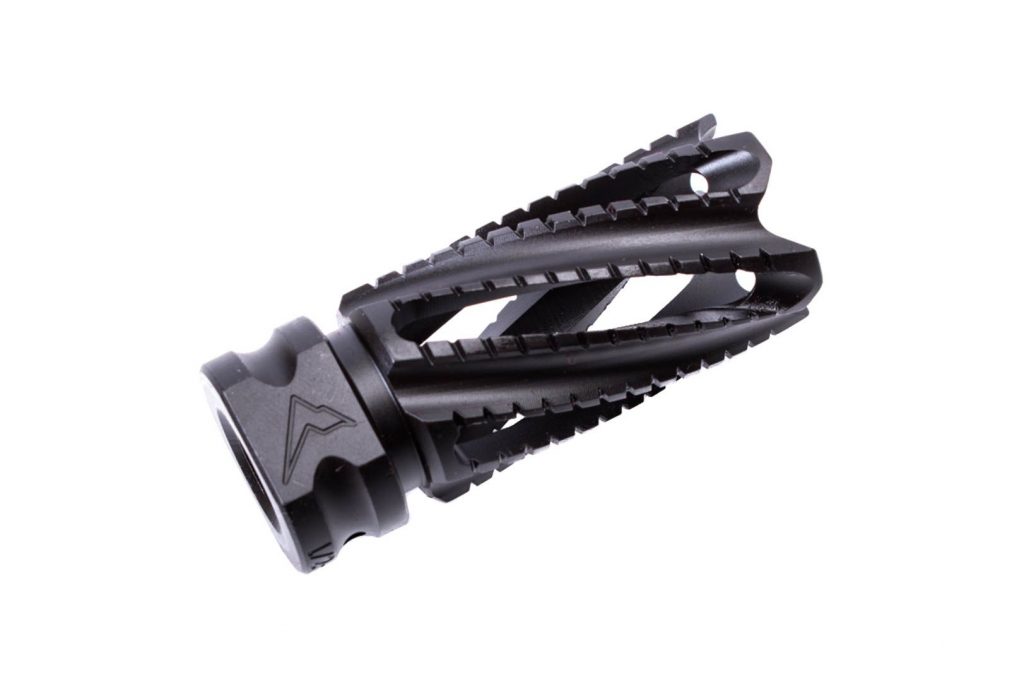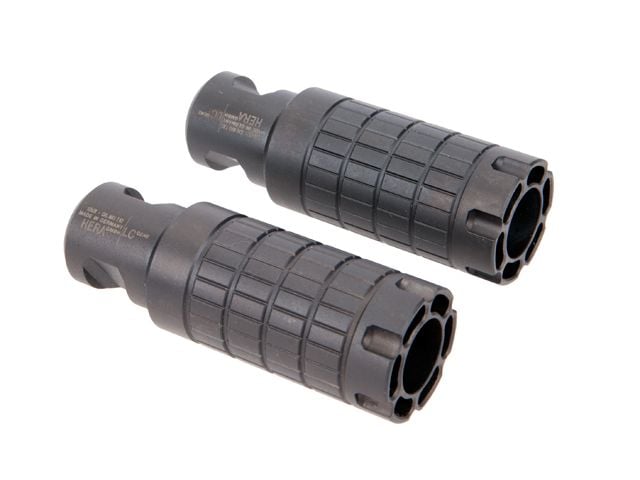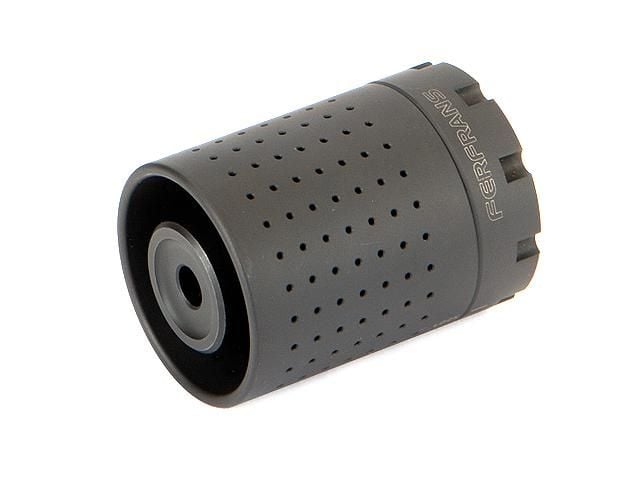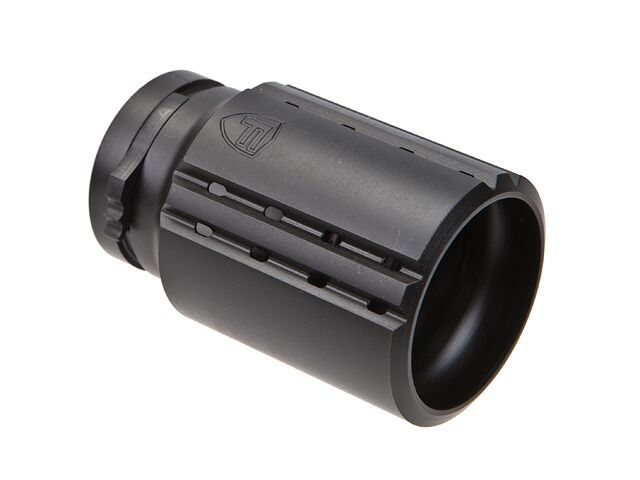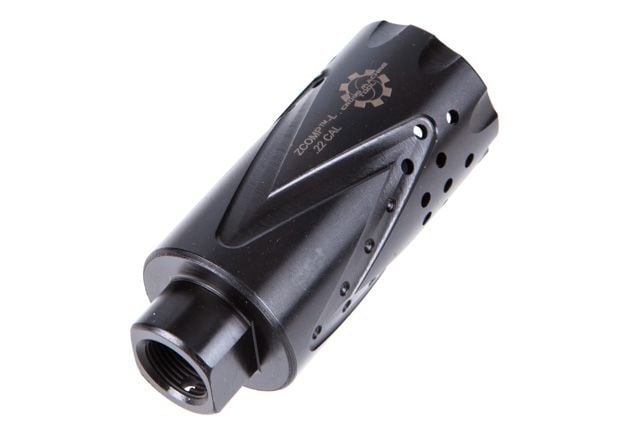The Best Muzzle Devices for Your AR15 Rifle
Today you’re going to find the best AR-15 muzzle device for you.
In fact:
We hand-tested 26 different muzzle devices for this review.
The best part?
We sorted the top 3 by use. So whether you’re on a budget or looking for the very best AR-15 muzzle device, you’ll find it here.
Let’s get started!
Table of contents:
- Why Use a Muzzle Device?
- The Difference Between a Muzzle Brake, Compensator, and Flash Hider
- Best AR-15 Muzzle Devices
- Best-Rated Muzzle Brakes
- Best AR-15 Flash Hiders
- Best AR-15 Compensators
- Which of These Muzzle Brakes Is Best For You?
Why Use a Muzzle Device?
They solve 3 core problems:
- Recoil
- Accuracy
- Flash/Dust
Muzzle brakes throw a brake on the recoil. Compensators reduce muzzle climb. Flash hiders make your bright fireballs disappear.
The best part?
It does this by a simple attachment to the end of your barrel.
The Difference Between a Muzzle Brake, Compensator, and Flash Hider
It's important to understand the different options available and how they can affect your shooting experience.
What is a Muzzle Brake?
A muzzle brake significantly reduces recoil. It achieves this by redirecting gases to the side.
Here are the pros/cons:
Pros
- Reduces recoil
- Improves speed
- Improves accuracy
Cons
- Creates louder side noise
- Increases barrel length (by about 3”)
If you need to make faster follow-up shots or you’re using larger cartridges (like .300 Blackout or AR-10 chambered in .338 Lapua), then a muzzle brake is for you.
However, if you intend to hunt - especially dangerous game - then don’t get a muzzle brake. It’ll deafen the people around you. Instead, we suggest you go with a compensator.
What is a Compensator?
A compensator reduces muzzle climb. It does this by redirecting gases to the top. Let’s see the pros and cons of using a compensator.
Pros:
- Improves speed
- Improves accuracy
- Reduces muzzle rise
- Reduces dust when shooting prone.
Cons:
- Hard to find a true compensator.
For people that want to improve accuracy or make faster follow-up shots, then get a compensator.
It significantly reduces your muzzle rise, making it easier to place a second shot. That’s why most combat forces and competitive shooters around the world use a compensator.
What is a Flash Hider?
A flash hider hides your AR-15’s fireballs. It works by redirecting the gases and reducing the amount of light that comes out of the barrel.
Shoot without flash hider:
And then after the flash hider is added:
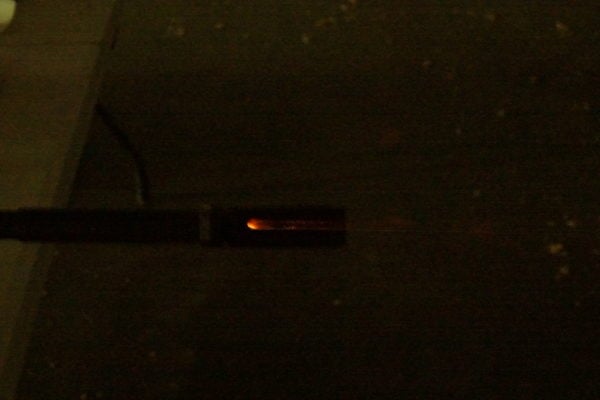
Pros
- Less disorientation
- Reduces light signature
- Useful with night vision.
Cons
- More expensive
- Banned in some states.
If you shoot at night or use night vision, then get a flash hider.
But what if flash hiders are banned in your state (like California)? In that case, go with a hybrid device. I’ll show you some down below.
So that sums up the differences between the three main types of muzzle devices.
3 Reasons to Upgrade Your Muzzle Device
Here are 3 reasons why you should upgrade your AR-15’s muzzle device...
- Reduces Recoil: The 5.56x45 mm doesn’t kick much. But, would you say no to even less kick with very few drawbacks? We wouldn’t.
- Reduces Flash: Going from massive fireballs to virtually nothing makes you a formidable nighttime predator.
- Improves Accuracy: Less muzzle climb = faster follow-up shots for improved accuracy.
Couple those 3 reasons together and you start to understand why pro shooters always use muzzle devices in their setups.
Convinced? Let’s talk products.
Best AR-15 Muzzle Devices
Let’s briefly look at the list of the best muzzle devices for your AR-15 rifle:
- Muzzle brakes
- Precision Armament Hypertap: The Best Overall Muzzle Brake
- Precision Armament M4-72
- Fortis MFG Muzzle Brake 5.56
- Flash hiders
- Rainier Arms FHV2 Flash Hider
- Zev Technologies Muzzle Device
- JMAC Customs GFH KeyMount Flash Hider
- Schmeisser .223/5.56 NO FLASH Muzzle Device w/ Glass Breaker - 1/2x28
- Compensators
Best-Rated Muzzle Brakes
Here are the best muzzle devices you should use on the next AR15 build.
1. Precision Armament Hypertap: The Best Overall Muzzle Brake
The Precision Armament Hypertap is the best overall muzzle brake.
In fact, the reticle movement is nearly eliminated. My follow-up shots are faster. And my overall accuracy skyrocketed.
How? Keep reading to find out.
Felt Recoil Reduction: The Hypertap claims to reduce recoil by 84% — the highest on the market.
Is it true? To figure out, I put the claim through an exhaustive “sled test”. 110 rounds later and I’ve concluded...it’s true.
The Precision Armament Hypertap reduces felt recoil by more than 80%. How is that possible?
Three things:
- 35-degree baffle angles
- Wide bore clearance of .06 inches
- State-of-the-art Convergent-Divergent porting
Put another way:
It’s engineered like no other muzzle brake on the market. As a result, you’ll be able to make more accurate and faster double-taps - ideal for competitions or combat scenarios.
Muzzle Climb: Out of the box, the Hypertap comes muzzle climb neutral. However, it has easy-to-tune gas biasing for the marksman who wants to get even more precision out of his shots.
Concussion/Noise: Recoil reduction and concussion go hand in hand.
When you tip the scale in one direction, you get more of the other. With the exceptionally high recoil reduction (over 80%), you can expect some powerful blasts.
At 6 feet behind the shooter, you can expect some felt concussion.
You’ll also want to make sure you are wearing ear protection if you are anywhere near a person shooting Hypertap, as the average decibel output is around 154.
Reliability: The Hypertap won’t break. It’s built with the highest quality heat-treated stainless steel.
Then, it’s coated with an Ionbond CrCN finish - which makes it nearly scratch-proof. Finally, it’s manufactured with a 5-axis simultaneous machining process.
The result?
An indestructible muzzle brake that’ll outlast your firearm.
Length/Weight: It’s compact and ergonomic.
Here are the Hypertap’s dimensions:
- Length: 2.54 inches
- Outer diameter: .86 inches
- Bore diameter: .28 inches
- Threading: .5 inches
- Weight: 3.07 ounces
Its smaller size makes the Hypertap perfect for sleek weapon profiles and transportability.
Ease of Cleaning: The Hypertap is insanely easy to clean.
Since it’s made with an open muzzle crown as well as fully exposed baffles, the Hypertap design prevents carbon deposits from building in the first place.
If they do happen to build up, however, the integrated universal timing nut makes it super easy to take off and clean.
All you need are the tools that come with the Hypertap, a cleaning solvent, and a rag.
Calibers Supported: The Hypertap is mainly used on .223 Remington/ 5.56 NATO caliber weapons.
However, they do make Hypertaps for:
- .9
- 6.5
- 8.6
- .45
- .308 Winchester
With these other calibers, expect recoil reduction to drop closer to 70%. If you are shooting 6.5 Creedmoor, Vg6 Precision makes an awesome brake called the Gamma 65.
Price: The Hypertap costs $179.99.
That’s way more expensive than any other muzzle brake on this list. But again, it’s the best one.
Precision Armament Hypertap Review: Is It Worth It? If you’re looking for the overall best muzzle brake for your .223, then get a Precision Armament Hypertap.
Here’s why. It’s:
- Compact
- High-quality build
- Easy to clean/remove
- INSANE recoil reduction
It’s the highest recoil reduction brake on the market. There’s zero muzzle flash increase. And my accuracy and speed doubled.
For less than $200, that’s a hell of a deal.
Price: $170.99
Buy now!
2. Precision Armament M4-72: The Best Valued Muzzle Brake
If you’re looking for the best-valued muzzle brake, then look no further than the Precision Armament M4-72.
It’s one of the lowest-priced muzzle brakes on the market, yet performs similarly to more expensive ones (like the Hypertap).
Interested?
Let’s break it down, starting with...
Felt Recoil Reduction: The felt recoil reduction came in at about 74%.
That’s about 10% less than PA’s Hypertap. Although it’s slightly less, I didn’t notice much of a difference.
Precision Armament achieved this by designing the M4-72 with two reverse vents on each side, 40-degree triple baffles, and a .060-inch bore clearance.
In short:
With that much recoil reduction, I was able to put out faster, more accurate shots. Stack that with the best AR-15 scope, and your accuracy will improve ten folds.
Muzzle Movement: My rifle didn’t move with the M4-72 attached.
Designed with a narrower signature on top, closed on the bottom, and top vents, I didn’t get any noticeable rise or twist of the muzzle.
The unique design also makes for a very low dust signature, so you won’t get that annoying blowback when shooting prone.
Noise/Concussion: If you don’t wear ear protection, this device WILL cause permanent hearing loss.
It is significantly louder than other devices because all the energy is directed to the sides. Anyone within a 10-foot radius and 60 degrees of the shooter should expect massive backblast and average noise around 120 dB.
So be sure to wear hearing protection!
Reliability: PA is known for making products that withstand extreme conditions and the M4-72 is no exception.
It’s machined with heat-treated stainless steel and an Ionbond CrCN high-temp finish similar to the Hypertap.
This means the M4-72 will last through heat, erosion, and the wear of repetitive use. It’s that reliable.
Ease of Cleaning: After I got the thing disassembled, there was nothing to the cleaning process.
The only problem was that unlike the Hypertap — which comes with everything you need to field strip — the Accu-Washers needed to install and take the M4-72 apart are sold separately.
Not a deal breaker, but something to keep in mind.
Dimensions: The Armament M4-72 is one of the most compact and lightweight compensators on the market.
The standard caliber option M4-72 came out of the box as follows:
- Length: 2.25”
- Largest diameter: .865”
- Weight: 2.55 oz.
Calibers Supported: The PA M4-72 Severe-Duty comes in two caliber options:
- 5.56mm/.223
- 7.62mm/.308
For higher calibers like .40 or .45, I like Kaw Valley Precision Linear Comp.
Price: Here’s the biggest difference between the M4-72 and the Hypertap:
The Hypertal retails at around $180, whereas the M4-72 sells for only $89.99.
For $50 less than some popular other brands, you get similar amounts of recoil reduction and all the benefits of muzzle control like quick double-taps.
Precision Armament M4-72 Review: Is It Worth It? If you can’t afford the Hypertap and looking for the second-best muzzle brake, then go for the Precision Armament M4-72.
Here’s why. It’s:
- Reliable
- Compact
- Affordable
- 74% Recoil Reduction
- Negligible Muzzle Rise
In short: Precision Armament’s M4-72 Severe-Duty Compensator will increase your speed and accuracy all at a price that won’t break the bank.
Price: $85.49
Buy now!
3. Fortis MFG Muzzle Brake 5.56
The Fortis Muzzle Brake is a top-quality product that was designed with sharp lines that reflect the brand's unique style.
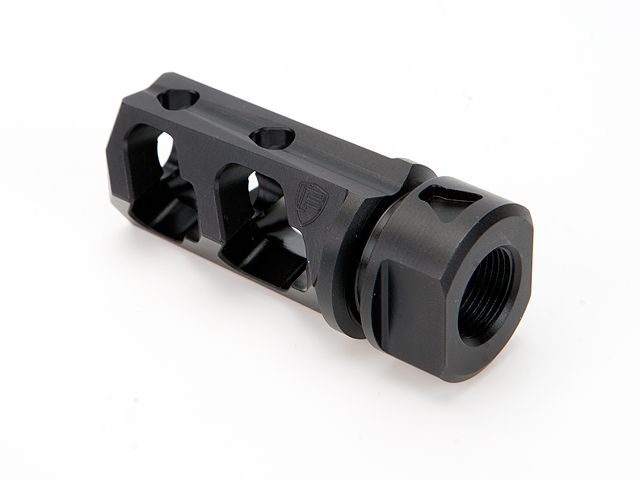
The team at Fortis takes pride in their work and dedicates the necessary time to ensure that they produce products that are not only of high quality but provide an exceptional experience to their customers.
Upon trying the Fortis Muzzle Brake, you will quickly realize that the performance of the product is unmatched and that muzzle rise is virtually non-existent.
With this brake, you can maintain their speed and accuracy while putting more rounds down range and on target.
Even in a build with an 18-inch barrel and a rifle-length gas system, recoil is only slightly more than that of a 22-magnum bolt action.
However, this brake is loud, and hearing protection should be worn at all times while using it.
It is ideal for hunting and target shooting and is sure to exceed your expectations.
Price: $94.95
Buy now!
Best AR-15 Flash Hiders
If you’re looking for the best AR-15 flash hiders on the market, then keep on reading…
1. Rainier Arms FHV2 Flash Hider
Rainier Arms Flash Hider is one of the best AR-15 flash hiders for the price.
It’s designed to muzzle flash to preserve the shooter's night vision by directing the gases away from the line of sight of the shooter and to reduce the flash visible to the enemy.
The black nitride finish provides the highest level of durability.
Price: $60.00
Buy now!
2. Zev Technologies Muzzle Device
The Zev Muzzle Device is a top-notch addition to any firearm, designed to provide the dual benefits of flash suppression and muzzle rise reduction.
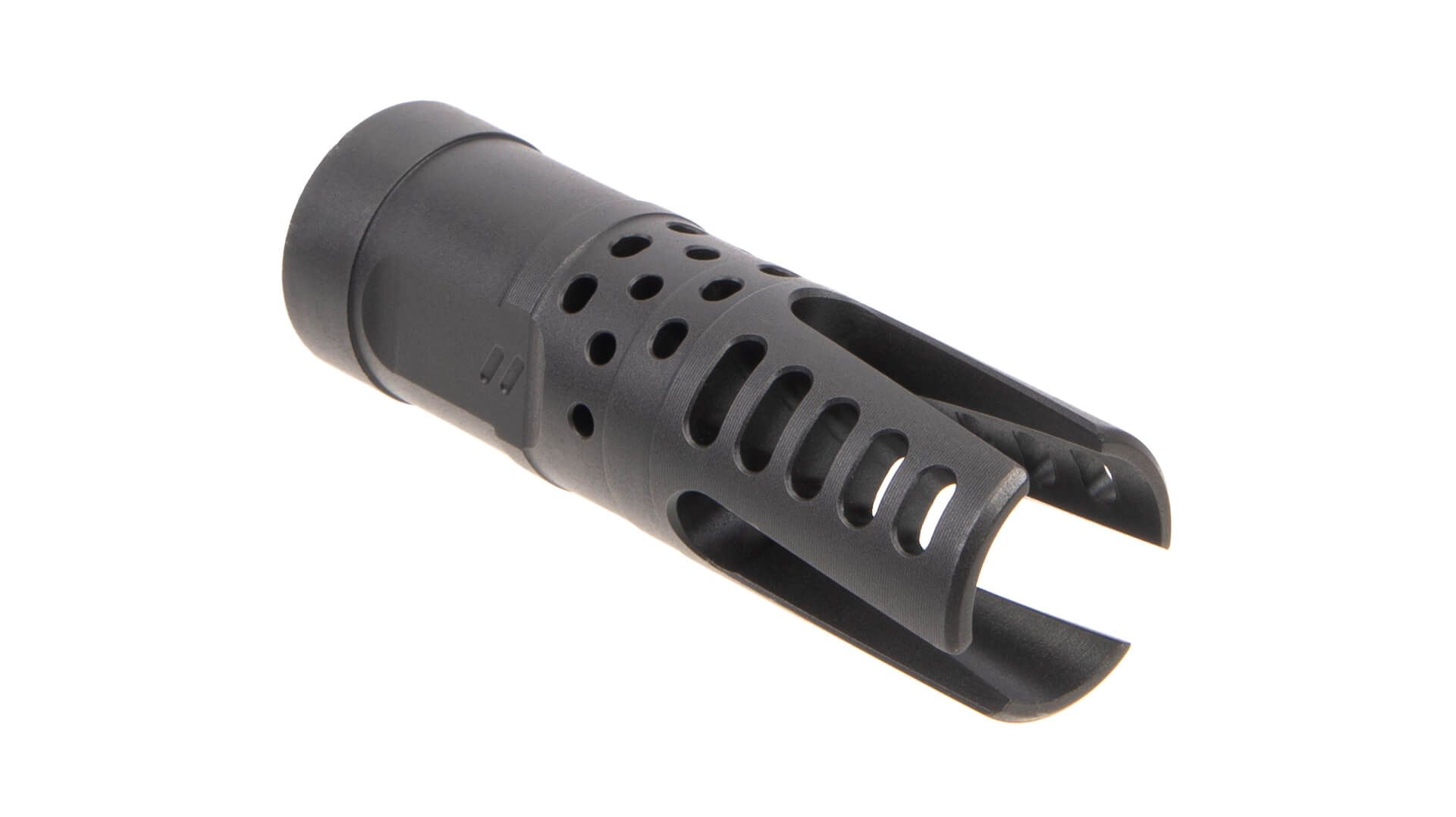
3. JMAC Customs GFH KeyMount Flash Hider
The GFH muzzle device is a high-quality combination of the German G36 flash hider and the DeadAir Silencers KeyMount.
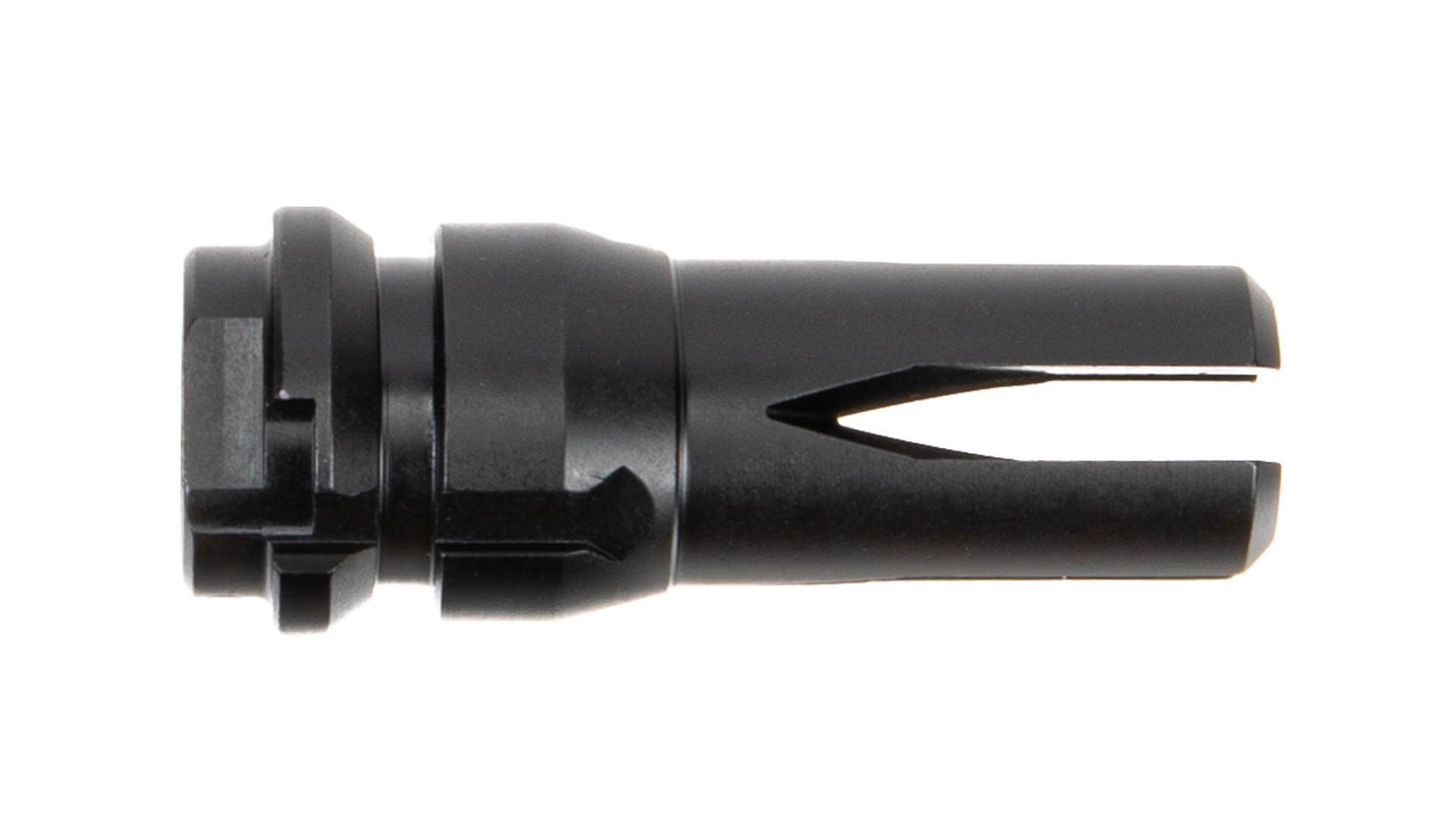
With only shims needed for timing and KeyMo and KeyMicro suppressor compatibility, installation is quick and easy.
Constructed from durable 17-4ph stainless steel with a black nitride finish, it's both stylish and functional.
It weighs in at just 3.46 ounces and is available in 1/2-28 or 5/8-24 threads, making it a versatile choice for a wide range of firearms.
Price: $94.46
Buy now!
4. Schmeisser .223/5.56 NO FLASH Muzzle Device w/ Glass Breaker - 1/2x28
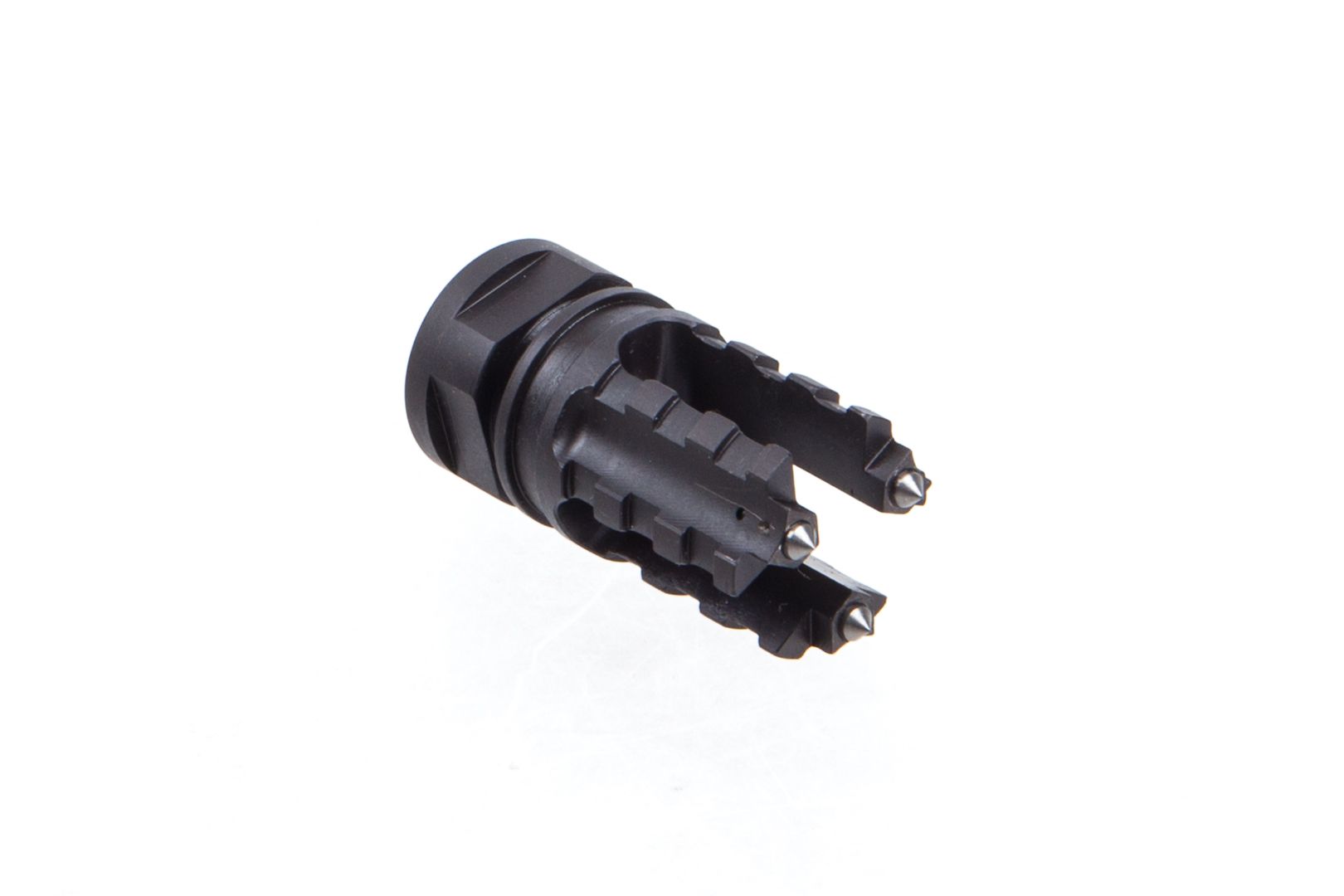
It’s made of 4140 German steel and features a matte black oxide finish.
It provides a high-performance flash hider for anti-glare shooting while defeating safety/security glass with little force.
Also, it's designed to fit standard 1/2x28 UNEF threads and weighs in at 2.08 oz, making it lightweight and easy to handle. The device's diameter is 0.86 in, and its length is 1.89 in.
However, this one can get a little costly compared to previous models.
Price: $175.95
Buy now!
Best AR-15 Compensators
Wondering what’s the best AR-15 compensator? Keep on reading to find out…
1. Hera Arms LC Linear Compensator Gen 2
Here are some of the top features:
- 12 separate expansion chambers
- Reduce Noise
- Gases escape straight from the front of the compensator, hence free float hand guards and rail systems like the HERA-ARMS IRS can overlap on the compensator
- Easy Installation
- 223 / 5.56 Linear Compensator for use on short-barreled rifles. The inside design with 12 separate expansion chambers leads blast and noise straight forward to increase shooting comfort and reduce noise at the shooter's ears. Generation 2 with 30% less weight and a reduced outside diameter for a perfect fit under our IRS handguard system.
These features combined make the Hera Arms Compensator one of the top-rated AR-15 compensators on the market.
Price: $119.00
Out of stock! Try an alternative instead: Bravo Company MFG (BCM) Extended M3 5.56 Compensator.
2. Ferfrans CQB Modular Muzzle Brake System
The new Ferfrans CQB Modular Muzzle Brake System is a 2 part system consisting of the performance Muzzle Brake Mount and the CRD (Concussive Reduction Device), which features a built-in quick attach/detach mechanism.
Ferfrans CQB Modular Muzzle Brake System allows you to run your gun with all the benefits of an efficient Brake/Compensator reducing muzzle rise.
When the need arises, simply attach the Concussive Reduction Device (CRD) via its quick detach mechanism and it redirects the percussion forward making it suitable for prone, CQB, out of vehicles, or on a crowded range. I’d definitely rank the Ferfans as one of the best AR-15 compensators.
Price: $199.00
Buy now!
3. Fortis Control Shield
You breach, shoot a few rounds, and then can't hear feedback from your team because you're temporarily deaf from the concussion and blast noise from your muzzle device.
The Fortis Control Shield was designed to push the noise forward for combative situations or even for simple range use, while the top ports keep the muzzle device flat on target. The patent pending quick detach system will be made available for other manufacturers to use in conjunction with their muzzle devices.
So whether you're knocking down doors or shooting at the range, let's help save your hearing. So click on the Control and go!
Price: $149.92
Buy now!
4. CMT Tactical ZCOMP Linear
Cross Machine Tool's ZCOMP LINEAR provides forward directional muzzle blast control desired on rifles with shorter barrels.
The outer diameter fluting and front nose cuts not only reduce the overall weight of the device but also blend with the aggressive aesthetic appearance of our Trademark magwell grooves on CMT UHP15 series Lower receivers. The function of the ZCOMP LINEAR muzzle device is equaled by the exceptional visible manufacturing quality & appearance you expect from Cross Machine Tool products. It’s also made in the good ol’ USA.
Price: $93.57
Buy now!
Which of These Muzzle Brakes Is Best For You?
To recap:
If you’re looking for the overall best muzzle brake, then get Precision Armament Hypertap. It reduces recoil by over 80%!
However, if you don’t want to spend that much, then I’d recommend the best-valued muzzle brake — the Precision Armament M4-72. It’s durable, easy to clean, and reduces recoil by about 74%.
Whatever muzzle brake you choose, you will hit a good, reliable one. I’ve fired more than 100 rounds through each one with no issues.
With that said, now I’d like to hear from you:
Which of these muzzle devices will you choose?
Whatever you choose, let me know in the comments down below. And if you’re interested in an AR-15 rifle scope, I’d recommend checking out this beginner's guide to Rifle Scopes.
Also read:
About the author:
Richard Douglas is a firearms expert and educator. His work has appeared on large gun publications like The National Interest, Daily Caller, ODU Magazine, American Shooting Journal, SOFREP and more. In his free time, he reviews various optics and firearms on his Scopes Field blog.



